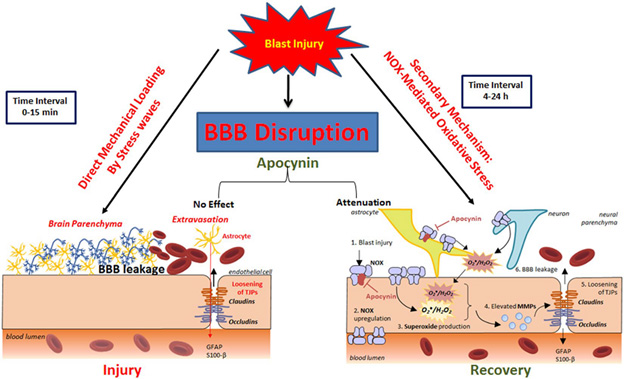The mechanisms and structures used by blood vessels in the brain to control movement of molecules and cells between the circulatory and central nervous systems is called the blood-brain barrier (BBB). Disruption of the BBB may cause neuronal dysfunction and tissue degeneration, and both blunt impact to the head and exposure to blast overpressure induce BBB permeability in animal models (for example, see Kuriakose, Rama Rao, Younger, & Chandra, 2018). Breakdown of the BBB has been shown to be influenced by oxidative stress after blunt impact, but this relationship is not established in models of blast overpressure exposure. A team from the New Jersey Institute of Technology recently investigated this association (Kuriakose et al., 2019).
The researchers exposed anesthetized rats to a single blast of 180 kPa peak overpressure in a shock tube. Thirty minutes before blast exposure, a group of rats were injected with apocynin, a compound that limits production of reactive oxygen species and lessens oxidative stress. A control group of rats was exposed to blast noise, but not overpressure. All rats were injected with Evans blue dye through their tail vein, with later appearance of this dye in brain tissue being indicative of BBB disruption. Brain tissue was collected and the tissue from the 15 minutes and four-hour marks after blast exposure were examined to observe changes at acute and sub-acute stages of injury, respectively.
There was significantly more Evans blue dye in the brain tissue of blast-exposed animals than in that of controls at both time points, indicating permeability of the BBB in acute and subacute stages of injury. There was no effect observed from apocynin treatment at the 15-minute time point, but at the four-hour time point the concentration of Evans blue dye was significantly lower in the apocynin group than in those exposed to blast overpressure but not given apocynin. These results suggest that oxidative stress may take time to develop and influence BBB permeability, but is an important factor in its sub-acute disruption. It also demonstrates that pre-exposure administration of apocynin does not counter acute vasculature rupture. Further, levels of tight junction proteins–responsible for maintaining a tight seal between adjacent cells–were significantly lower in blast-exposed rats than in controls at the four-hour time point. Apocynin countered this effect, returning levels of tight junction proteins to those similar to controls. Figure 1 provides the authors' model of results from their study.
In summary, this study links oxidative stress to disruption of the BBB after exposure to blast overpressure in subacute stages of injury. Further research in this area could benefit Service members by suggesting targets for early-intervention traumatic brain injury therapeutics.

Kuriakose, M., Rama Rao, K.V., Younger, D., and Chandra, N. (2018). Temporal and spatial effects of blast overpressure on blood-brain barrier permeability in traumatic brain injury. Scientific Reports, 8(1), 8681.
Kuriakose, M., Younger, D., Ravula, A.R., Alay, E., Rama Rao, K.V., and Chandra, N. (2019). Synergistic role of oxidative stress and blood-brain barrier permeability as injury mechanisms in the acute pathophysiology of blast-induced neurotrauma. Scientific Reports, 9(1), 7717.
Your 15 minute session will timeout in approximately 10 minutes.
If you're in the middle of entering information, please close this warning and save your progress (if possible) or finish up your task.
If your session fully times out, you will lose any un-saved work.
Your current Blast Injury Research Program session has expired.
Your next click will take you away from the private area, and you will lose any work you have in-progress.
Please enter your email address, and try again.